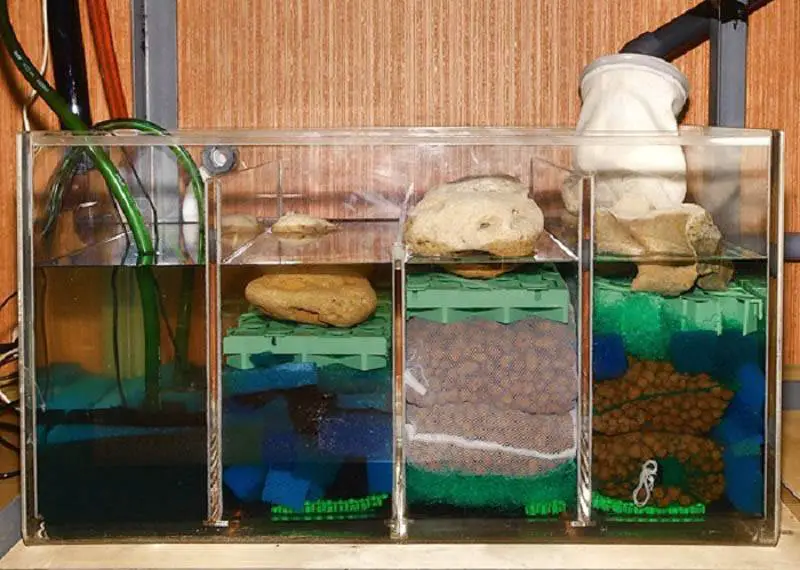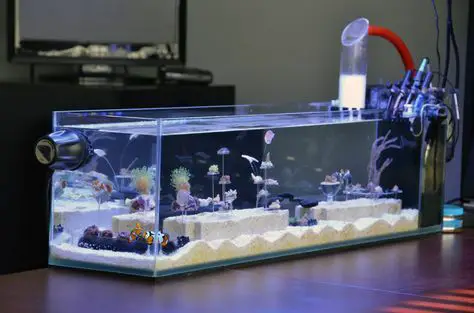When moving from a freshwater aquarium to a saltwater habitat, you may be faced with new equipment and the high requirements of fish for environmental conditions.
At the same time, saltwater aquariums are distinguished by their exoticism, beauty and a wide range of directions for the creativity of aquarists.
Making salt water is an easy way to add salt to your aquarium and make it more suitable for fish.

Table of Contents
saltwater aquarium water parameters
Marine aquarium water standards include:
| salt water aquarium water parameters | Required parameters |
| medium pH | 8.1–8.3 |
| Carbonate hardness | 7–11 dkH 125–200 ppm CaCO3 |
| Calcium | 380–400 ppm (mg/l) |
| Nitrates | <0.2 ppm (mg/l) |
| Nitrites | <0.2 ppm (mg/l) |
| Phosphates | <0.03 ppm (mg/l) |
| Magnesium | 1250–1350 ppm (mg/l) |
| Ammonia | <0.1 ppm (mg/l) |
| Salinity | 35 ppt (mg/l) |
| Temperature | 24-26°C |
| Density | 1.026 g/cm3 |
To measure water indicators, the following devices are required :
- refractometer (salinity and density);
- digital hydrometer (specific gravity);
- proprietary tests to measure the concentration of trace elements.
saltwater aquarium pros and cons
Before you start arranging an ecosystem, you should weigh all the pros and cons of this laborious undertaking:
| saltwater aquarium pros | saltwater aquarium cons |
| A memorable appearance, as the main decoration of the interior. | Expensive equipment and maintenance. |
| A variety of options in the choice of inhabitants and elements. | Accuracy in respect of water parameters and verification of compliance with the help of special instruments and reagents. |
| Possibility of coral breeding. | The laborious process of water renewal. |
| Reduced need for frequent cleaning unlike freshwater counterparts. | Providing the aquarium with proper filtration and aeration. |
| Opportunity to earn income from the sale of fry. | The choice of a certain type of soil for the arrangement of the ecosystem. |
What supplies do you need for a saltwater aquarium?
The choice of an aquarium and equipment for its arrangement is a large-scale space for creativity.
When choosing the aquarium itself, you may encounter the following options:
- Angular.
- Wall.
- Panoramic.
- Classic or rectangular.
- carousel type.
Equipment types
When choosing technical elements of equipment, it is necessary to pay attention to the quality and lack of reaction to saltwater.
Carefully! Oxidation of elements can lead to the penetration of toxins dangerous to organisms into the water.
saltwater aquarium equipment list:
- mechanical filtration (carried out through synthetic winterizer or foam rubber layers);
- biofiltration;
- chemical filtration (activated carbon);
- external filter;
- lighting (metal halide lamps, LED lamps, T5 lamps);
- fridge;
- adjustable heater;
- pumps (2 pcs).
how to make salt water for aquarium?
Seawater is salt water that is the basis of the ecosystem and an indispensable element in the care of exotic fish.
What will be needed to make salt water for aquarium
To make salt water for aquarium you will need:
- sea salt from a pet store;
- reverse osmosis filter.
To prepare the water of a marine aquarium, it is necessary to use a reverse osmosis filter, the principle of operation of which is set to remove impurities and partially preserve oxygen.
Important! When preparing saltwater, you can only use specialized sea salt for aquariums, which can be purchased at pet stores.
Process of preparing salt water for aquarium
After installing the reverse osmosis filter, you can start preparing water for the aquarium:
- Water enters the pre-filter.
- Purified water goes through the stages of reverse osmosis inside the equipment.
- Clean water comes out through the faucet and is used for accumulation in the tank.
- Salt for marine aquariums (40g/1l) is added.
It is necessary to purchase salt with a margin so that the fish always have access to renewed water.
saltwater habitats for fish tank
Depending on the flora and fauna chosen, the care and maintenance of the ecosystem can become easier (the presence of corals or mollusks as natural filters).
| popular saltwater aquarium fish for beginners | |
| Fish | Fiery Angel, Blue Surgeon, Yellow Zebrasoma, Clownfish, Royal Gram, Antias, Frenatus, Dogfish. |
| Plants | Pinnate Caulerpa, Deciduous Caulerpa, |
| Invertebrates | Starfish (Asterodiscus red), Sea urchins, Jellyfish Eared Aurelia, Tube worms. |
| corals | Soft: Anemones, Stolonifers, Horn corals, Gorgonians. Tough: Madrepore corals, Scleractinia, Galaxea, Caulastraea, Lobophyllia, Tubastreya. Non-photosynthetic: Dendrophilia, Tubastreya, Scleroneftia. |
| arthropods | Shooter Crab, Boxer Crab, Hermit Crab, Harlequin Shrimp. |
| cephalopods | Nautiluses, Octopuses, Cuttlefish, Mollusks, Squids, Snails. |
| Elements | Live rocks, Dry reef rocks, Live sand. |
Peculiarities! The starfish Asterina can be dangerous to corals in a marine aquarium ecosystem. In the event of signs of destruction (white spots), a natural enemy of the starfish, the harlequin shrimp, should be introduced.
Along with living stones, you can accidentally acquire some unwanted living organisms :
- mantis shrimp;
- polychaete carnivorous worms;
- Actinia “Glass Rose”;
- planaria.
Infection with bacterial organisms can not be feared, since they are food for living stones.
marine tank setup for beginners
Settling an aquarium with marine life is far from the first and not the most troublesome stage in the arrangement of the ecosystem. Before starting work, you must read the instructions for the devices used.

Preparation marine tank
A phased launch of the marine aquarium:
- Assemble an aquarium.
- Connect filters.
- Decorate the space with decorative elements.
- Check for grounding.
- Pour prepared osmosis water 3/4 into the tank.
- Add salt to marine aquariums.
- Turn on service elements (filters, pumps, heating, lighting).
- Check the operation of the equipment, and the state of the dissolved salt (should completely dissolve).
- Measure the salinity and temperature of the water.
- Add sand.
- Layout living stones for further maturation of water. The duration of maturation is from 4 to 8 weeks with a weekly replacement of 10% of the total volume.
Important! Under no circumstances should ordinary water be used for a marine aquarium. It is important to remember that water for such an ecosystem is prepared in advance.
In the process of preparing water for the launch of living organisms, consistency and regular testing of the environment is important. One of the important stages is the gradual laying out of living stones, no more than 3 per day with constant testing for the content of ammonia and nitrites.
If the amount of trace elements goes beyond the norm, it is necessary to stop the addition of living stone, and replace part of the water in the ecosystem.
planting plant organisms
Unlike freshwater aquariums, in which plants act as pests, in ecosystems with seawater, algae actively participate in the cycle of organic substances.
Features of the development of plant organisms:
- If there are no herbivorous fish in the ecosystem, the increasing amount of algae can interfere with the corals.
- The most convenient way of settling is adding along with live stones.
In the marine ecosystem, plants perform the function of feeding and are highly aesthetic as a decorative element.
Settlement of fish
The most important tips for planting fish:
- Populate no more than 3 individuals at a time.
- Lower the container with fish into the tank until the temperature equalizes.
- Replace a quarter of the water in the tank with aquarium water.
- After 60 minutes, repeat the previous procedure.
- After 4 hours, the fish are planted in a tank with the remaining water.
During the procedure and after it, it is necessary to monitor the amount of nitrogen-containing compounds in the aquarium.
Important! Planting corals is carried out according to a similar algorithm. The procedure is carried out 2 months after the launch of the fish.
Further care
Many inhabitants of marine aquariums are endemic or extremely whimsical living organisms.
Mandatory weekly routines include:
- 5% of the total saltwater is replaced every week;
- water replacement and topping up is carried out only after the osmosis procedure;
- cleaning the bottom from the result of the life process of the inhabitants and food residues;
- replacement of activated carbon in the filter;
- checking the condition of the filter and refugium;
- fixing the fasting day in the nutrition of the wards.
In addition to weekly procedures, it is necessary to use iodine and ferroadditives.
Conclusion
A marine aquarium is a complex artificial system that requires the knowledge and experience of an aquarist. Marine aquatic organisms are sensitive to changing conditions and need constant care.
Despite the high financial costs, the aquarium is one of the best design solutions, which becomes not only an elegant exhibit, but also effectively brightens up leisure.
Making salt water for aquariums is a relatively simple process that can be completed in a few steps. By following the guidelines provided in this article, you can create a salt water mix that is perfect for your aquarium.